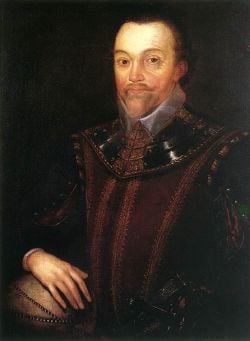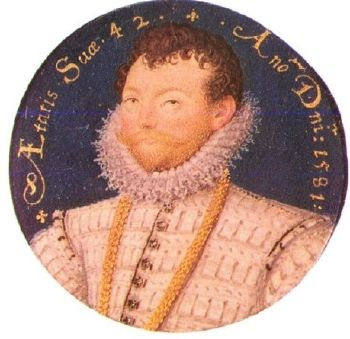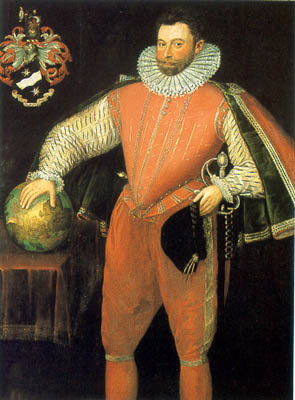Francis Drake
| Sir Francis Drake |
|---|
| Born |
| c. 1540s Tavistock, Devon |
| Died |
| January 28th 1596 Porto Belo, Panama |
Sir Francis Drake, Vice Admiral, (c. 1540 – January 28 1596) was a pre-eminent English navigator, politician, civil engineer, and known slave trader, of the Elizabethan age. He became the first Englishman to circumnavigate the globe, and the second circumnavigation of the world in a single expedition, from 1577 to 1580. Queen Elizabeth thought very highly of him and appointed him second-in-command of the English fleet that sailed against the Spanish Armada in 1588.
Although he was famous for his courage in battle, he was not liked by some of his peers. His legendary exploits made him a hero among the English but to the Spaniards he was equated with the devil himself. He was known as "El Dragón" for his actions. King Philip II placed a bounty on Drake's head of 20,000 ducats; about 10 million US dollars.
Drake's exploits made a significant contribution to the birth of what became the British Empire, as Elizabeth turned her attention away from ambitions in Europe towards the Americas and beyond, where her colony of Virginia was established. Drake's activities thus set the stage for Elizabeth's subjects to settle in North America, where they brought with them notions of religious liberty, of civil society composed of voluntary associations, out of which would arise American democracy.
Birth and early years
Francis Drake was born in the parish of Crowndale, a mile south of Tavistock, Devon, probably in February or March 1540. As with many of Drake's contemporaries, the exact date of his birth is unknown and could be as early as 1535. Francis was the eldest of 12 children born to Edmund Drake (1518–1585), a Protestant farmer who later became a preacher, and his wife Mary Mylwaye. Francis was a grandson of John Drake and Margaret Cole. He is sometimes confused with his cousin John Drake (1573–1634), who was the son of Edmund's older brother, Richard Drake. His maternal grandfather was Richard Mylwaye. John Drake and Margaret Cole were also great-grandparents of Sir Walter Raleigh.
He was reportedly named after his godfather Francis Russell, 2nd Earl of Bedford, and throughout his cousins' lineages there are direct connections to royalty and famous persons, such as Sir Richard Grenville, Ivor Callely, Amy Grenville, and Geoffrey Chaucer. His father was a tenant of the Earl of Bedford, and must have stood well with him, for Francis Russell, the heir of the earldom, was the boy's godfather."
During the Roman Catholic uprising of 1549, the family was forced to flee to Kent. At about the age of 13, Francis took to the sea on a cargo barque, becoming master of the ship at the age of 20. He spent his early career honing his sailing skills on the difficult waters of the North Sea, and after the death of the captain he became master of his own barque. At age 23, Drake made his first voyage to the New World under the sails of the Hawkins family of Plymouth, in company with his second cousin, Sir John Hawkins.
Entering the Pacific
In 1577, Drake was commissioned by Queen Elizabeth to undertake an expedition against the Spanish along the Pacific coast of the Americas. He set out to depart from Plymouth on November 15 on his expedition, but terrible weather threatened him and his fleet, who were forced to take refuge in Falmouth, from where they returned to Plymouth for repair. After this minor setback, he set sail once again from England on December 13, aboard the Pelican, with four other ships and 164 men. After crossing the Atlantic, one of the ships, under Thomas Winter turned back through the Magellan Strait, on the east coast of South America.
The four remaining ships departed for the Magellan Strait at the southern tip of the continent. This course established "Drake's Passage" but the route south of Tierra del Fuego around Cape Horn was not discovered until 1616. Drake crossed from the Atlantic to the Pacific through the Magellan Strait. After this passage a storm blew his ship so far south that he realized Tierra del Fuego was not part of a southern continent, as was believed at that time. This voyage established Drake as the first Antarctic explorer, because the southernmost point of his voyage was at least 56 degrees according to astronomical data quoted in Haklyut's "The Principall Navigators" of 1589. This achievement was not surpassed until James Cook's voyage of 1773 and was the first known occasion that any explorer had traveled further south than any other human being.
A few weeks later Drake made it to the Pacific, but violent storms destroyed one of the ships and caused another to return to England. He pushed onwards in his lone flagship, now renamed the Golden Hind in honor of Sir Christopher Hatton (after his coat of arms). The Golden Hind sailed north alone along the Pacific coast of South America, attacking Spanish ports and rifling towns as it went. Some Spanish ships were captured, and Drake made good use of their more accurate charts.
The most notable seizures included a Spanish ship, ladened with riches from Peru including 25,000 pezos of pure, fine gold, amounting in value to 37,000 ducats of Spanish money. Near Lima, Drake discovered news of a ship sailing towards Panama, The Cacafuego. He gave chase and eventually captured her, which proved to be the most profitable capture. He found 80 pounds of gold, a gold crucifix, countless jewels, 13 chests full of royal plate and 26 tons of silver.
Nova Albion
On June 17, 1579, Drake landed somewhere north of Spain's northern-most claim at Point Loma. He found a good port, landed, repaired and restocked his vessels, then stayed for a time, keeping friendly relations with the natives. It is said that he left behind many of his men as a small colony, but his planned return voyages to the colony were never realized. He claimed the land in the name of the Holy Trinity for the English Crown as called Nova Albion—Latin for "New Britain."
The precise location of the port was carefully guarded to keep it secret from the Spaniards, and several of Drake's maps may even have been altered to this end. All first hand records from the voyage, including logs, paintings, and charts were lost when Whitehall Palace burned in 1698. A bronze plaque inscribed with Drake's claim to the new lands, fitting the description in Drake's own account, was discovered in Marin County, California. This so-called Drake's Plate of Brass was later declared a hoax.
Another location often claimed to be Nova Albion is Whale Cove (Oregon), although to date there is no evidence to suggest this, other than a general resemblance to a single map penned a decade after the landing. Several other locations have been suggested in both Oregon and California. For example, in 2008 Garry Gitzen posited Nehalem Bay, Oregon, as the true New Albion.
However, in 2012, after years of conducting its own review of the research, the Department of the Interior designated Drake's Cove in Drake's Bay, California, as a National Historic Landmark: the official site of Drake's landing. In 2020, the California State Historical Resources Commission approved Drake's Bay as the site of New Albion, a California Historical Landmark.[1]
The colonial claims were established with full knowledge of Drake's claims, which they reinforced, and remained valid in the minds of the English colonists on the Atlantic coast when those colonies became free states. Maps made soon after would have "Nova Albion" written above the entire northern frontier of New Spain. These territorial claims became important during the negotiations that ended the Mexican-American War between the United States and Mexico.
Continuing the journey
Drake now headed westward across the Pacific, and a few months later reached the Moluccas, a group of islands in the southwest Pacific, in eastern modern-day Indonesia. While there, the Golden Hind became caught on a reef and was almost lost. After three days of waiting for expedient tides and dumping cargo, the bark was miraculously freed. Drake and his men befriended a sultan king of the Moluccas and involved themselves in some intrigues with the Portuguese there.
He made multiple stops on his way toward the tip of Africa, eventually rounded the Cape of Good Hope, and reached Sierra Leone by July 22, 1580. On September 26, the Golden Hind sailed into Plymouth with Drake and 59 remaining crew aboard, along with a rich cargo of spices and captured Spanish treasures. The Queen's half-share of the cargo surpassed the rest of the crown's income for that entire year. Hailed as the first Englishman to circumnavigate the Earth (and the second such voyage overall, after Magellan's in 1520), Drake was knighted by Queen Elizabeth aboard the Golden Hind on April 4, 1581, and became the Mayor of Plymouth and a Member of Parliament.
The Queen ordered all written accounts of Drake's voyage to be considered classified information, and its participants sworn to silence on pain of death; her aim was to keep Drake's activities away from the eyes of rival Spain.
The Spanish Armada
War broke out between Spain and England in 1585. Drake sailed to the New World and sacked the ports of Santo Domingo and Cartagena. On the return leg of the voyage, he captured the Spanish fort of San Augustíne in Florida. These exploits encouraged Philip II of Spain to order the planning for an invasion of England.
In a pre-emptive strike, Drake "singed the King of Spain's beard" by sailing a fleet into Cadiz, one of Spain's main ports, and occupied the harbor for three days, capturing six ships and destroying 31 others as well as a large quantity of stores. The attack delayed the Spanish invasion by a year.
Drake was vice admiral in command of the English fleet (under Lord Howard of Effingham) when it overcame the Spanish Armada that was attempting to invade England in 1588. As the English fleet pursued the Armada up the English Channel in closing darkness, Drake put duty second and captured the Spanish galleon Rosario, along with Admiral Pedro de Valdés and all his crew. The Spanish ship was known to be carrying substantial funds to pay the Spanish Army in the Low Countries. Drake's ship had been leading the English pursuit of the Armada by means of a lantern. By extinguishing this for the capture, Drake put the fleet into disarray overnight. This exemplified Drake's ability, as a privateer, to suspend strategic purpose if a tactical profit were on offer.
On the night of July 29, along with Howard, Drake organized fire-ships, causing the majority of the Spanish captains to break formation and sail out of Calais into the open sea. The next day, Drake was present at the Battle of Gravelines.
The most famous (but probably apocryphal) anecdote about Drake relates that, prior to the battle, he was playing a game of bowls on Plymouth Hoe. On being warned of the approach of the Spanish fleet, Drake is said to have remarked that there was plenty of time to finish the game and still beat the Spaniards. This battle was the high point of the remarkable mariner's career. In fact tidal conditions caused some delay in the launching of the English fleet as the Spanish drew nearer so it is easy to see how a popular myth of Drake's cavalier attitude to the Spanish threat may have originated.
In 1589, the year after defeating the Armada, Drake was sent to support the rebels in Portugal, which opposed the personal union of Spain and Portugal under King Philip II of Spain in 1580. En route, he sacked the city of La Coruña in Spain. This massive combined naval and land expedition (see "English Armada") was a dismal failure, attributed to a grievous lack of organization, poor training, and paltry supplies. It was a crucial turning point in the Anglo-Spanish War (1585).
Controversies
Slave Trading
Drake and Sir John Hawkins made the first English slave-trading expeditions, making his fortune through the sale of West Africans. Around 1563 Drake first sailed west to the Spanish Main, on a ship owned by his uncle John Hawkins, with a cargo of people forcibly removed from the coast of West Africa. Drake planned to sell the Africans into slavery in Spanish plantations. But Drake took an immediate dislike to the Spanish, at least in part due to their Catholicism and inherent mistrust of non-Spaniards. His hostility is said to have increased over an incident at San Juan de Ulua in 1568, when, while delivering his human cargo, a Spanish fleet took him by surprise. Although he was in an enemy port, it was conventional for the Spanish to 'surrender' for a few hours in order to purchase control of the kidnap victims. Thus, it was unusual for a fleet of enemy warships to appear out of the blue. Drake survived the attack largely because of his ability to swim. From then on, he devoted his life to working against the Spanish Empire; the Spanish considered him an outlaw pirate, but to England he was simply a sailor and privateer. On his second such voyage, he fought a battle against Spanish forces that cost many English lives but earned him the favor of Queen Elizabeth.
Conflict in the Caribbean
The most celebrated of Drake's Caribbean adventures was his capture of the Spanish Silver Train at Nombre de Dios in March 1573. With a crew including many French privateers and Maroons — African slaves who had escaped the Spanish — Drake raided the waters around Darien (in modern Panama) and tracked the Silver Train to the nearby port of Nombre de Dios. He made off with a fortune in gold, but had to leave behind another fortune in silver, because it was too heavy to carry back to England. It was during this expedition that he climbed a high tree in the central mountains of the Isthmus of Panama and thus became the first Englishman to see the Pacific Ocean.
When Drake returned to Plymouth on August 9, 1573, a mere 30 Englishmen returned with him, every one of them rich for life. However, Queen Elizabeth, who had up to this point sponsored and encouraged Drake's raids, signed a temporary truce with King Philip II of Spain, and so was unable to officially acknowledge Drake's accomplishment.
Final years
Drake's seafaring career continued into his mid fifties. In 1595, following a disastrous campaign against Spanish America, where he suffered several defeats in a row, he unsuccessfully attacked San Juan, Puerto Rico. The Spanish gunners from El Morro Castle shot a cannonball through the cabin of Drake's flagship, but he survived. In 1596, he died of dysentery while anchored off the coast of Porto Belo, Panama where some Spanish treasure ships had sought shelter. He was buried at sea in a lead coffin, near Portobelo, Panama.
Legacy
Drake's exploits as an explorer have become an irrevocable part of the world's subconsciousness, particularly in Europe. Numerous stories and fictional adaptations of his adventures exist to this day. Considered a hero in England, it is said that if England is ever in peril, beating Drake's Drum will cause Drake to return to save the country. This is a variation of the sleeping hero folk-tale.
During his circumnavigation of the globe, Drake left a plate upon leaving his landing place on the west coast of North America, claiming the land for England. In the 1930s, it appeared that Drake's plate had been found near San Francisco. Forty years later, scientists confirmed that the plate was a hoax, as had been suspected. Later information attributed the hoax to E Clampus Vitus.
Drake's adventures, though less known in the United States, still have some effect. For instance, a major east-west road in Marin County, California is named Sir Francis Drake Boulevard. It connects Point San Quentin on San Francisco Bay with Point Reyes and Drakes Bay. Each end is near a site considered by some to be Drake's landing place.
Notes
- ↑ 2020 Actions Taken California Office of Historical Preservation. Retrieved February 10, 2022.
ReferencesISBN links support NWE through referral fees
- Bawlf, R. Samuel. The Secret Voyage of Sir Francis Drake, 1577-1580. New York : Walker, 2003. ISBN 978-0802714053
- Coote, Stephen. Drake: the life and legend of an Elizabethan hero. New York: Thomas Dunne Books, 2003. ISBN 978-0312341657
- Gitzen, Garry. Sir Francis Drake in Nehalem Bay. lulu.com, 2012. ISBN 1105227049
- Hughes-Hallett, Lucy. Heroes: A History of Hero Worship. Alfred A. Knopf, New York, New York, 2004. ISBN 1400043999.
- Rodger, N.A.M. The Safeguard of the Sea; A Naval History of Britain 660-1649. W. W. Norton & Co Inc, 1998. ISBN 978-0393045796
- Turner, Michael. In Drake's Wake: The Early Voyages. Empire Pub Service, 2006. ISBN 1904959210
External links
All links retrieved April 9, 2024.
- Tour of Drake's Circumnavigation
- In Drake's Wake
- Mission to rescue Drake's body
- Kraus Collection of Sir Francis Drake at the Library of Congress
- Sir Francis Drake History.com.
Credits
New World Encyclopedia writers and editors rewrote and completed the Wikipedia article in accordance with New World Encyclopedia standards. This article abides by terms of the Creative Commons CC-by-sa 3.0 License (CC-by-sa), which may be used and disseminated with proper attribution. Credit is due under the terms of this license that can reference both the New World Encyclopedia contributors and the selfless volunteer contributors of the Wikimedia Foundation. To cite this article click here for a list of acceptable citing formats.The history of earlier contributions by wikipedians is accessible to researchers here:
The history of this article since it was imported to New World Encyclopedia:
Note: Some restrictions may apply to use of individual images which are separately licensed.


